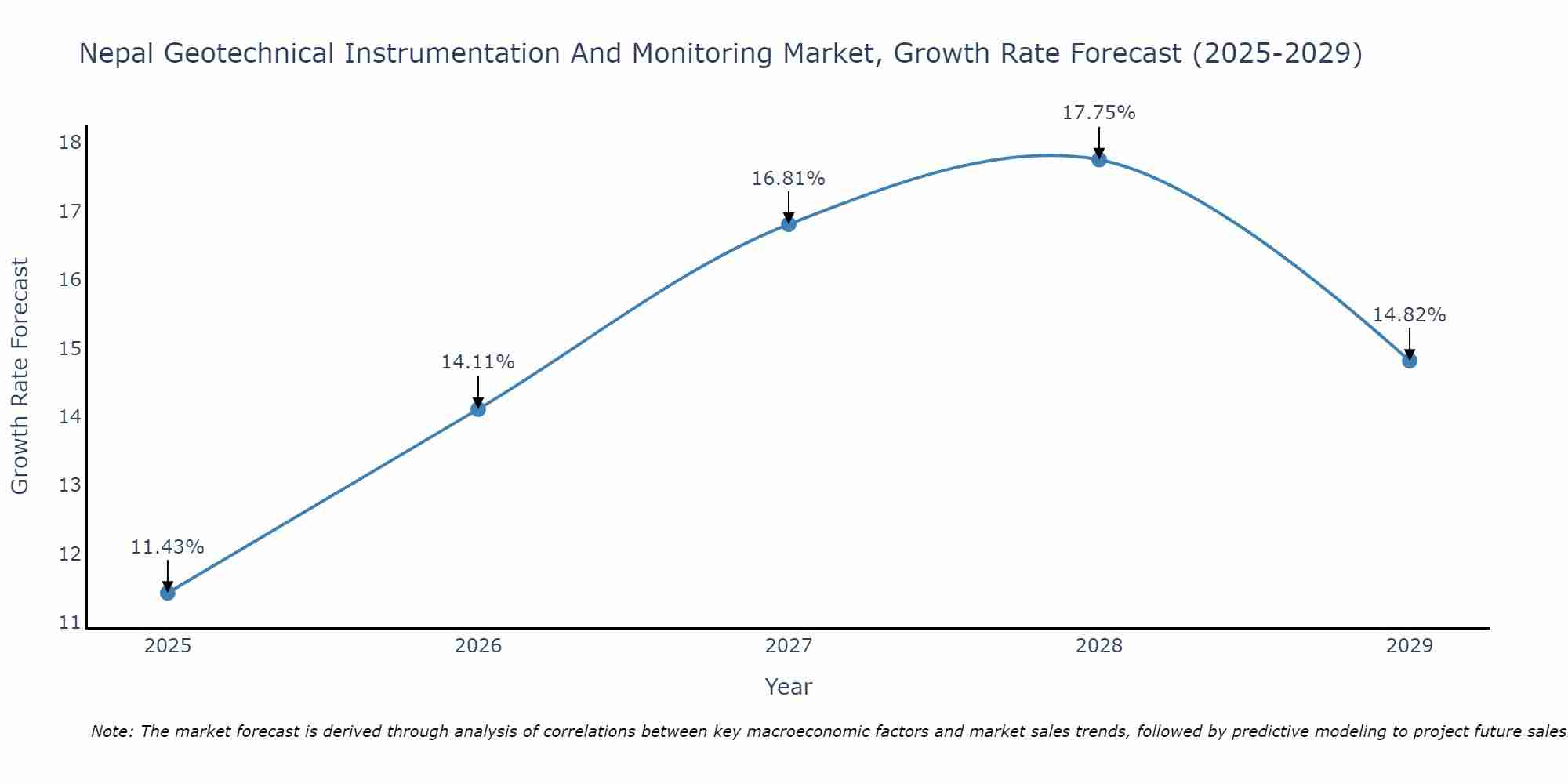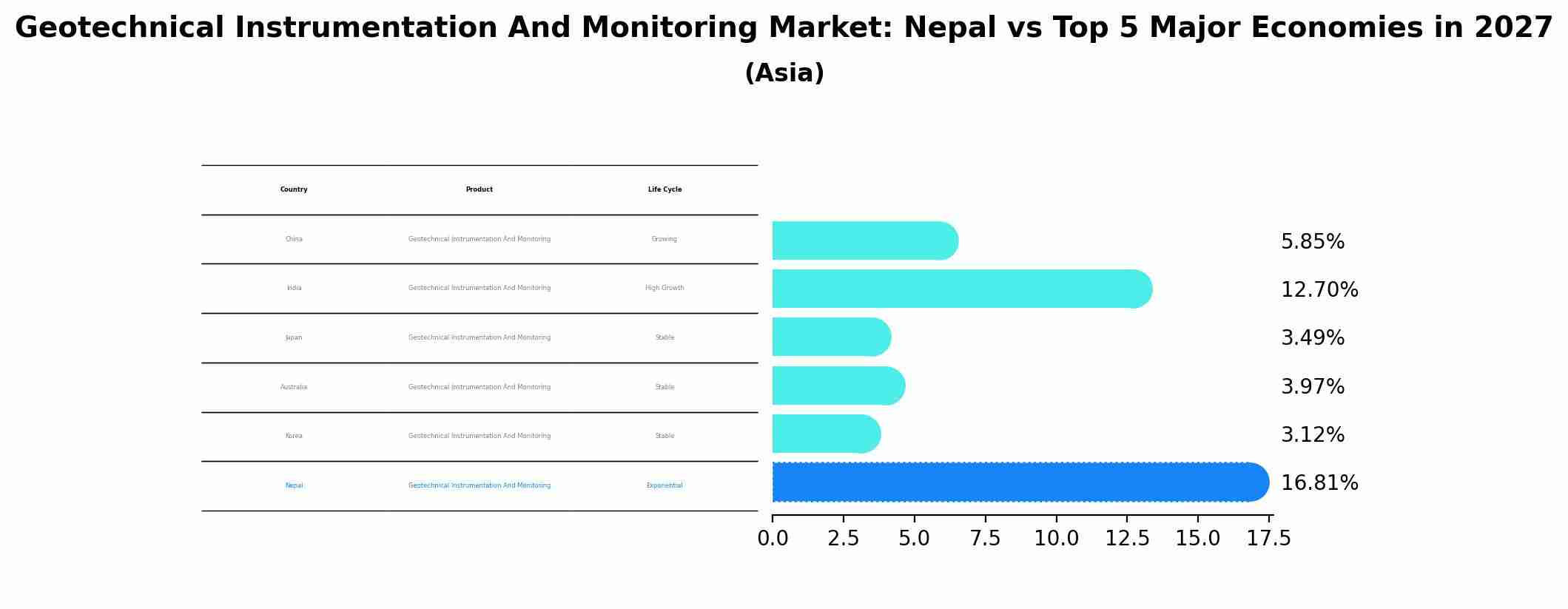Nepal Geotechnical Instrumentation And Monitoring Market (2025-2031) Outlook | Value, Growth, Trends, Forecast, Companies, Industry, Share, Revenue, Size & Analysis
| Product Code: ETC364536 | Publication Date: Aug 2022 | Updated Date: Aug 2025 | Product Type: Market Research Report | |
| Publisher: 6Wresearch | Author: Summon Dutta | No. of Pages: 75 | No. of Figures: 35 | No. of Tables: 20 |
Nepal Geotechnical Instrumentation And Monitoring Market Size Growth Rate
The Nepal Geotechnical Instrumentation And Monitoring Market is projected to witness mixed growth rate patterns during 2025 to 2029. Growth accelerates to 17.75% in 2028, following an initial rate of 11.43%, before easing to 14.82% at the end of the period.

Geotechnical Instrumentation And Monitoring Market: Nepal vs Top 5 Major Economies in 2027 (Asia)
Nepal's Geotechnical Instrumentation And Monitoring market is anticipated to experience a exponential growth rate of 16.81% by 2027, reflecting trends observed in the largest economy China, followed by India, Japan, Australia and South Korea.

Nepal Geotechnical Instrumentation And Monitoring Market Synopsis
The Nepal Geotechnical Instrumentation and Monitoring Market is witnessing steady growth due to increasing infrastructure development projects, urbanization, and a growing awareness of the importance of monitoring geological conditions for safety. Key players in the market offer a wide range of instruments such as inclinometers, piezometers, extensometers, and seismometers for monitoring factors like soil stability, groundwater levels, and seismic activity. The demand for these instruments is driven by the need to ensure the safety and stability of construction projects, transportation networks, and natural disaster mitigation efforts. Government initiatives to improve geotechnical monitoring practices further contribute to market growth, with opportunities for expansion in sectors like construction, mining, and environmental monitoring. Collaboration between industry stakeholders and research institutions also plays a crucial role in advancing technologies and enhancing market competitiveness.
Nepal Geotechnical Instrumentation And Monitoring Market Trends
The Nepal Geotechnical Instrumentation and Monitoring market is experiencing a growing demand for advanced technologies such as remote monitoring systems, real-time data analysis, and digital sensors. This trend is driven by the increasing emphasis on infrastructure development projects in Nepal, including roads, bridges, dams, and buildings. The market is also witnessing a shift towards more sustainable and environmentally friendly solutions, with a focus on reducing risks associated with geotechnical issues such as landslides and soil erosion. Additionally, there is a rising awareness among stakeholders about the importance of accurate and timely monitoring of geotechnical conditions to ensure the safety and longevity of infrastructure projects. Overall, the Nepal Geotechnical Instrumentation and Monitoring market is poised for steady growth as the country continues to invest in its infrastructure development.
Nepal Geotechnical Instrumentation And Monitoring Market Challenges
In the Nepal Geotechnical Instrumentation and Monitoring market, some key challenges include limited awareness and understanding of the importance of geotechnical instrumentation among stakeholders, inadequate infrastructure for monitoring systems, lack of skilled professionals to operate and analyze monitoring data, and limited investment in advanced technologies. Additionally, the rugged terrain and difficult weather conditions in Nepal can pose challenges for the installation and maintenance of monitoring equipment. Addressing these challenges will require increased education and training programs, investment in infrastructure development, and collaboration between government agencies, private sector companies, and academic institutions to improve the overall geotechnical monitoring capabilities in the country.
Nepal Geotechnical Instrumentation And Monitoring Market Investment Opportunities
The Nepal Geotechnical Instrumentation and Monitoring market presents lucrative investment opportunities due to the country`s increasing infrastructure development projects and the need for monitoring services to ensure construction safety. Investors can consider opportunities in providing geotechnical instrumentation such as inclinometers, piezometers, and settlement gauges, as well as monitoring services for projects like road construction, hydropower plants, and buildings. Additionally, there is a growing demand for real-time monitoring solutions utilizing technologies like IoT and remote sensing. Collaborating with local engineering firms and government agencies to offer comprehensive monitoring solutions tailored to Nepal`s geotechnical challenges can be a strategic approach for investors looking to capitalize on this emerging market.
Jordan Agar Market Government Policies
The government of Nepal has implemented various policies related to the Geotechnical Instrumentation and Monitoring market to ensure the safety and stability of infrastructure projects. These policies include regulations on the installation and maintenance of geotechnical instruments, guidelines for data collection and analysis, and requirements for monitoring and reporting of geotechnical data. Additionally, the government promotes the use of advanced technology and equipment in geotechnical monitoring to improve the accuracy and efficiency of data collection. The policies aim to enhance the overall quality of construction projects, mitigate risks of geological hazards, and support sustainable development in Nepal. Compliance with these policies is crucial for companies operating in the Geotechnical Instrumentation and Monitoring market to contribute to the country`s infrastructure development while ensuring safety and environmental protection.
Nepal Geotechnical Instrumentation And Monitoring Market Future Outlook
The Nepal Geotechnical Instrumentation and Monitoring market is poised for significant growth in the coming years due to increasing infrastructure development projects, urbanization, and a growing emphasis on safety and risk management in construction activities. The demand for geotechnical instrumentation and monitoring services is expected to rise as the country invests in critical infrastructure such as roads, bridges, dams, and buildings. Additionally, the adoption of advanced technologies for real-time monitoring and data analysis is likely to drive market expansion. As Nepal continues to prioritize sustainable development and disaster risk reduction, there will be a growing need for geotechnical solutions to ensure the stability and safety of structures in seismic-prone regions. Overall, the market outlook for geotechnical instrumentation and monitoring in Nepal appears promising with opportunities for innovation and growth.
Key Highlights of the Report:
- Nepal Geotechnical Instrumentation And Monitoring Market Outlook
- Market Size of Nepal Geotechnical Instrumentation And Monitoring Market, 2024
- Forecast of Nepal Geotechnical Instrumentation And Monitoring Market, 2031
- Historical Data and Forecast of Nepal Geotechnical Instrumentation And Monitoring Revenues & Volume for the Period 2021 - 2031
- Nepal Geotechnical Instrumentation And Monitoring Market Trend Evolution
- Nepal Geotechnical Instrumentation And Monitoring Market Drivers and Challenges
- Nepal Geotechnical Instrumentation And Monitoring Price Trends
- Nepal Geotechnical Instrumentation And Monitoring Porter's Five Forces
- Nepal Geotechnical Instrumentation And Monitoring Industry Life Cycle
- Historical Data and Forecast of Nepal Geotechnical Instrumentation And Monitoring Market Revenues & Volume By Offerings for the Period 2021 - 2031
- Historical Data and Forecast of Nepal Geotechnical Instrumentation And Monitoring Market Revenues & Volume By Hardware for the Period 2021 - 2031
- Historical Data and Forecast of Nepal Geotechnical Instrumentation And Monitoring Market Revenues & Volume By Software for the Period 2021 - 2031
- Historical Data and Forecast of Nepal Geotechnical Instrumentation And Monitoring Market Revenues & Volume By Structure for the Period 2021 - 2031
- Historical Data and Forecast of Nepal Geotechnical Instrumentation And Monitoring Market Revenues & Volume By Tunnels & Bridges for the Period 2021 - 2031
- Historical Data and Forecast of Nepal Geotechnical Instrumentation And Monitoring Market Revenues & Volume By Buildings & Utilities for the Period 2021 - 2031
- Historical Data and Forecast of Nepal Geotechnical Instrumentation And Monitoring Market Revenues & Volume By Dams for the Period 2021 - 2031
- Historical Data and Forecast of Nepal Geotechnical Instrumentation And Monitoring Market Revenues & Volume By Pipelines for the Period 2021 - 2031
- Historical Data and Forecast of Nepal Geotechnical Instrumentation And Monitoring Market Revenues & Volume By Others for the Period 2021 - 2031
- Historical Data and Forecast of Nepal Geotechnical Instrumentation And Monitoring Market Revenues & Volume By End Use for the Period 2021 - 2031
- Historical Data and Forecast of Nepal Geotechnical Instrumentation And Monitoring Market Revenues & Volume By Buildings & Infrastructure for the Period 2021 - 2031
- Historical Data and Forecast of Nepal Geotechnical Instrumentation And Monitoring Market Revenues & Volume By Energy & Power for the Period 2021 - 2031
- Historical Data and Forecast of Nepal Geotechnical Instrumentation And Monitoring Market Revenues & Volume By Oil & Gas for the Period 2021 - 2031
- Historical Data and Forecast of Nepal Geotechnical Instrumentation And Monitoring Market Revenues & Volume By Mining for the Period 2021 - 2031
- Historical Data and Forecast of Nepal Geotechnical Instrumentation And Monitoring Market Revenues & Volume By Others for the Period 2021 - 2031
- Nepal Geotechnical Instrumentation And Monitoring Import Export Trade Statistics
- Market Opportunity Assessment By Offerings
- Market Opportunity Assessment By Structure
- Market Opportunity Assessment By End Use
- Nepal Geotechnical Instrumentation And Monitoring Top Companies Market Share
- Nepal Geotechnical Instrumentation And Monitoring Competitive Benchmarking By Technical and Operational Parameters
- Nepal Geotechnical Instrumentation And Monitoring Company Profiles
- Nepal Geotechnical Instrumentation And Monitoring Key Strategic Recommendations
Frequently Asked Questions About the Market Study (FAQs):
- Single User License$ 1,995
- Department License$ 2,400
- Site License$ 3,120
- Global License$ 3,795
Search
Thought Leadership and Analyst Meet
Our Clients
Related Reports
- Australia Briquette Market (2025-2031) | Growth, Size, Revenue, Forecast, Analysis, Trends, Value, Share, Industry & Companies
- Vietnam System Integrator Market (2025-2031) | Size, Companies, Analysis, Industry, Value, Forecast, Growth, Trends, Revenue & Share
- ASEAN and Thailand Brain Health Supplements Market (2025-2031) | Strategy, Consumer Insights, Analysis, Investment Trends, Opportunities, Growth, Size, Share, Industry, Revenue, Segments, Value, Segmentation, Supply, Forecast, Restraints, Outlook, Competition, Drivers, Trends, Demand, Pricing Analysis, Competitive, Strategic Insights, Companies, Challenges
- ASEAN Bearings Market (2025-2031) | Strategy, Consumer Insights, Analysis, Investment Trends, Opportunities, Growth, Size, Share, Industry, Revenue, Segments, Value, Segmentation, Supply, Forecast, Restraints, Outlook, Competition, Drivers, Trends, Demand, Pricing Analysis, Competitive, Strategic Insights, Companies, Challenges
- Europe Flooring Market (2025-2031) | Outlook, Share, Industry, Trends, Forecast, Companies, Revenue, Size, Analysis, Growth & Value
- Saudi Arabia Manlift Market (2025-2031) | Outlook, Size, Growth, Trends, Companies, Industry, Revenue, Value, Share, Forecast & Analysis
- Uganda Excavator, Crane, and Wheel Loaders Market (2025-2031) | Strategy, Consumer Insights, Analysis, Investment Trends, Opportunities, Growth, Size, Share, Industry, Revenue, Segments, Value, Segmentation, Supply, Forecast, Restraints, Outlook, Competition, Drivers, Trends, Demand, Pricing Analysis, Competitive, Strategic Insights, Companies, Challenges
- Rwanda Excavator, Crane, and Wheel Loaders Market (2025-2031) | Strategy, Consumer Insights, Analysis, Investment Trends, Opportunities, Growth, Size, Share, Industry, Revenue, Segments, Value, Segmentation, Supply, Forecast, Restraints, Outlook, Competition, Drivers, Trends, Demand, Pricing Analysis, Competitive, Strategic Insights, Companies, Challenges
- Kenya Excavator, Crane, and Wheel Loaders Market (2025-2031) | Strategy, Consumer Insights, Analysis, Investment Trends, Opportunities, Growth, Size, Share, Industry, Revenue, Segments, Value, Segmentation, Supply, Forecast, Restraints, Outlook, Competition, Drivers, Trends, Demand, Pricing Analysis, Competitive, Strategic Insights, Companies, Challenges
- Angola Excavator, Crane, and Wheel Loaders Market (2025-2031) | Strategy, Consumer Insights, Analysis, Investment Trends, Opportunities, Growth, Size, Share, Industry, Revenue, Segments, Value, Segmentation, Supply, Forecast, Restraints, Outlook, Competition, Drivers, Trends, Demand, Pricing Analysis, Competitive, Strategic Insights, Companies, Challenges
Industry Events and Analyst Meet
Whitepaper
- Middle East & Africa Commercial Security Market Click here to view more.
- Middle East & Africa Fire Safety Systems & Equipment Market Click here to view more.
- GCC Drone Market Click here to view more.
- Middle East Lighting Fixture Market Click here to view more.
- GCC Physical & Perimeter Security Market Click here to view more.
6WResearch In News
- Doha a strategic location for EV manufacturing hub: IPA Qatar
- Demand for luxury TVs surging in the GCC, says Samsung
- Empowering Growth: The Thriving Journey of Bangladesh’s Cable Industry
- Demand for luxury TVs surging in the GCC, says Samsung
- Video call with a traditional healer? Once unthinkable, it’s now common in South Africa
- Intelligent Buildings To Smooth GCC’s Path To Net Zero


















